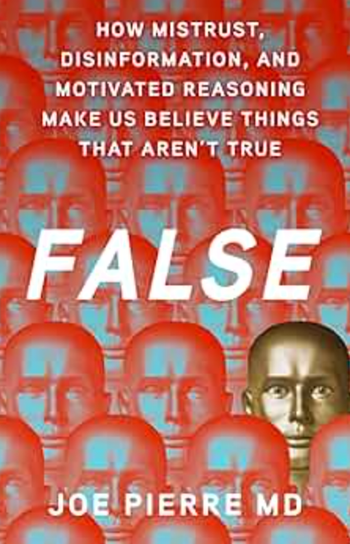
- Vol 40, Issue 5
Exploring Surprising Parallels Between The Sixth Sense and a Real Case
"My attitude toward The Sixth Sense shifted when I realized that I had been treating a patient whose death date was set before our appointments began..."
I still remember The Sixth Sense (1999). There must be a reason because the film never appealed to me, despite its many Academy Award nominations and the acclaim showered on director M. Night Shyamalan. One might expect the film’s plot to speak to me, since the protagonist is a psychologist and a major character is psychotic. Psychologists are not the same as psychiatrists, but both types of professionals treat mental illness, and the words themselves are close enough to cause confusion. However, the distinction between psychiatrists, who are physicians first, and psychologists, who are not medically trained, is important to the “plot” of the “story” that I am about to tell.
The Sixth Sense was among the many turn-of-the-millennium movies that bypassed linear time and confused the past with the present. It stars Bruce Willis, who is better known for his action-adventure roles and retired from acting in 2022 following an aphasia diagnosis. Willis plays Dr Malcolm Crowe, an eminent child psychologist who is haunted by the plight of young patient he could not cure. The little boy in question claims to communicate with the dead. Indeed, the boy turned out to be correct (by fiction’s standards) because he was the only person who could hear Dr Crowe speak. By the time the film ends, we learn that Dr Crowe had died in the film’s very first scene, when he’s shot by a vengeful patient.
My attitude toward The Sixth Sense shifted when I realized that I had been treating a patient whose death date was set before our appointments began. To be sure, I never intended to treat a dead patient—although, in hindsight, clues were hiding in plain sight, much as they were in Shyamalan’s film. Bombarded by flashbacks about the movie, I replayed the plot in my mind. It finally made sense. I could understand its eerie appeal, even if was not me who was dead. Let me explain.
“Bo” was a middle-aged man who was new to the New York City psychotherapeutic culture, where almost everyone sees a therapist. But he was not new to New York, per se. He lived in a rent-controlled apartment in a 6-story walk-up, having “inherited” the hard-to-get lease via his divorce. The shabby elevator-less building did not meet building code and would have been illegal had it been built in the 1990s, rather than in the 1890s. Still, the location was excellent for Bo’s purposes. It was near Soho, close to art galleries, and within walking distance from my office.
After his ever-disapproving father died, Bo sought a therapist’s help to broach their fraught relationship. Months had passed, and his mourning period had ended, but his mood swings had become erratic. When he started to talk of
By the time he arrived at my office, Bo perceived that people were following him and monitoring his thoughts—an ominous sign, to be sure. He explained that some cousins also had “special perceptions,” but they lived so far away in Maine that no one was the wiser. Besides, it was Stephen King country, where strange events were expected to occur. Little was known about the mental health of Bo’s parents.
Although remote, this family history of
We evaluated our options. Bo did not intend to act on his thoughts of
While awaiting a medical evaluation by his primary care physician, we chose to start treatment. Bo’s psychotic symptoms responded quickly to an atypical antipsychotic that could also stabilize the labile moods described by the therapist. With a little dose tweaking, he sounded normal, except that he still ruminated about his father’s condemnation of his career choice. In his father’s eyes, Bo should have remained in his hometown, rather than relocating to New York City and risking an unpredictable art career.
A few months later, Bo’s therapist phoned to say that he was in the emergency department and would miss his appointment. When we spoke directly, the therapist said that “he mentioned something about panic attacks.” He started sweating, and half his body went numb. He described pins and needles on the opposite half of his face. “Must be hysteria,” said the therapist, who was training to be a psychoanalyst. To me, her description sounded like contralateral paresthesia, but before I could comment, she added that “his conflicts about success are putting him at odds with his father, so he gets anxious and breaks into a sweat.”
Yes, it is entirely possible that Bo feared surpassing his father’s accomplishments, but the therapist’s description of contralateral neurological symptoms had an entirely different significance to physicians who learned that the facial nerves are controlled by the same side of the brain, whereas the brain’s opposite side governs the body. In other words, a lesion on the left side of the brain cause paralysis on the body’s right side, but facial nerve palsies occur on the same side. Brain lesions can produce such seemingly contradictory effects. The information she provided was important, but it put the patient’s symptoms in the neurological realm and demanded a medical evaluation before a
More data became available sooner than expected. Bo’s son saw his father stumble on the stairs, while dragging one leg behind him. So he whisked Bo off to the emergency department, which in turn whisked Bo off to radiology, where an MRI was read on the spot. It showed old strokes. Nothing acute appeared on imaging, even though he had just experienced new symptoms. By the time Bo left the x-ray department and was transferred upstairs, his symptoms had abated, suggesting that this time around, he’d had a transient ischemic attack. Still, something ominous was involved, especially since he did not smoke or use
The neuroradiologist said that the strokes were old and predated the prescription for his antipsychotic agent, assuaging my fears that the atypical antipsychotic I prescribed contributed to his condition. His newer psychiatric symptoms, on the other hand, could be explained by the location of one cerebrovascular accident (CVA).
The neurologist could not explain how this chain of events had happened in an otherwise unsusceptible individual. After a battery of tests confirmed that Bo was not in immediate danger of another cerebrovascular event, he was discharged home and referred for more cardiology and hematology work-ups. Neurology started anticoagulants to prevent further events. Eventually someone said that “it must be a coagulation disorder” and sent him to hematology, which ran more tests, without finding a cause.
In the back of my mind, I thought about the hypercoagulability that accompanies certain cancers, but Bo had already been seen by an army of specialists, none of whom found anything awry and none of whom were as interested in correlating the location of his brain lesions with his psychiatric symptoms as I.
For my part, I was impressed by how quickly my patient rebounded. He had a few short weeks of word-finding difficulties—suggesting that his “episode” was more than a transient ischemic attack—but he was back to baseline a month later. Maybe he was even better than before because his art had improved enough to interest a Chelsea gallery owner he met at an opening. The gallery owner added one of Bo’s paintings to a group show. Perhaps his anxiety propelled his art. Alternatively, perhaps his strokes disinhibited him enough to produce more unique imagery. This turn of events reminded me of an older folk artist who won a museum show after CVAs distorted her perception and changed her figures’ proportions.
A year passed without another episode. Bo was encouraged when the neurologist lowered his medications. In the interim, he continued to paint and continued to make an acceptable—albeit not lavish—living as an adjunct art teacher. His low rent made it possible to remain in New York. His artistic output was prodigious. There was talk of his being signed onto this gallery and offered a 1-person show. Someone hinted that he had a chance at the acclaimed Whitney Biennial in upper Manhattan.
In other words, Bo’s future looked better than before. His son was back in the picture, and their relationship rebounded. Bo’s anxiety about his unexplained medical condition faded as time passed. He continued therapy, mostly to discuss his father’s dismissive attitude toward his art career.
He also continued his appointments with me, during which we reviewed the risks and benefits of
It turned out that my worst fears about a full-blown stroke were unfounded. Another CVA did not occur, nor did any new neurological symptoms. Suicidal ideas disappeared, and the Bo no longer believed that special agents were trailing him. But something worse than a CVA happened, if that’s imaginable.
One day, Bo cancelled his appointment because of a “medical emergency”—without leaving details. I held my breath. Was it a real CVA this time around? An incapacitating one? I called. And that is when I learned that my patient’s time line ended the year before we met.
Doctors detected an invasive and uncommon
And that is when I realized that my patient’s book of life had been sealed before I met him and that his days on Earth were already limited. None of his many specialists saw this coming, and none of his many tests hinted at its presence. The journals confirmed that such tumors are unusually aggressive and are rarely symptomatic until little to nothing can be done to change their course. But he’d just had his best year ever, with almost enough time to achieve his life goals. He would never live long enough to attend his 1-person show or to see his paintings in a museum, but he realized that his work would live on long after he left this Earth and that was reassuring. Plus, he had reconciled with his son.
Looking back, would anything have made a difference? For sure, identifying his so-called “panic attacks” as neurological events made all the difference in the world. Preventative treatment was started, and the patient was spared a potentially deadly or disabling stroke that very well might have ended everything. A massive CVA might have stopped him from holding a paintbrush—or blinded him altogether.
That part of the story was a great accomplishment—one that makes me thankful that psychiatrists are physicians first. But would Bo’s choices have been different had he known he had only 1 year left of life? What if he himself believed that he was essentially dead? Would he have abandoned his art altogether and put the métier that gave his life meaning on the back burner? Would he have set off on a road trip like Ben Gazzara, the protagonist in Run for Your Life (1965-1968)? In that 1960s-era TV series, Gazzara played an attorney who was told that he would be dead in 2 years. So he set out to see and do everything he could during the time that he was (erroneously) allotted.
Alternatively, learning of a terminal diagnosis might have left Bo too depressed to create any art at all, too depressed to enjoy his remaining time, or too unmotivated to speed down the interstate or ride the rails, like his fictional television counterpart.
In this case, the choice was not his to make. Even his doctors did not have time to deliberate what to tell him. Still, the larger philosophical questions remain.
Yet one thing is certain: In hindsight, I am happy that I could treat someone who was theoretically dead already and make a difference in the days he had left, all because I did not know that his death date had been set.
Dr Packer is an assistant clinical professor of psychiatry and behavioral sciences at Icahn School of Medicine at Mount Sinai in New York, New York.
Articles in this issue
over 2 years ago
Substance Use Among Adolescents and Young Adultsover 2 years ago
The Urgent Need to Address Youth Mental Healthover 2 years ago
White House Announces Record Health Insurance Enrollmentover 2 years ago
Hospital Foodover 2 years ago
Lithium: Past, Present, and Futureover 2 years ago
Investigating the Impact of ADHD on Smoking Cessation Outcomesover 2 years ago
Aerobic Exercise: Benefits Following Brain Injuryover 2 years ago
Social Psychiatric PredictionsNewsletter
Receive trusted psychiatric news, expert analysis, and clinical insights — subscribe today to support your practice and your patients.














